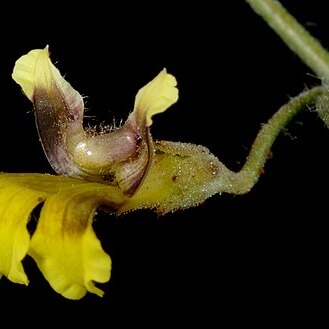Spreading to prostrate (erect when young), annual to 0.15 m high, to 0.8 m wide. Indumentum monomorphic (except for a small patch of crisped hairs on the corolla spur), hirsute (long unicellular, appressed to spreading to erect, tubercle-based, eglandular hairs), very dense on new growth, sparse to moderately dense on older growth, 0.25–1.25 (–1.6) mm long, 0.03 mm wide on stems. Leaves all cauline, ovate, broadly oblanceolate or narrowly obovate (narrowly ovate when young); lamina 21–45 mm long, 8.5–18 mm wide, flat, margin dentate except near the base (a single leaf with four prominent lobes towards the base), not recurved, midrib obscure adaxially, prominent abaxially, acute to obtuse apex, dried brownish green, weakly discolorous, paler abaxially, adaxial and abaxial surfaces sparsely to moderately densely hispid, slightly denser abaxially, very gradually tapered at the base (not auriculate); petiole 11–23 mm long on seedling (basal) leaves, only 1–3 mm long on mature (upper cauline) leaves; leaves becoming smaller and petioles shorter distally, eventually bract-like along the inflorescence. Inflorescence a terminal (or occasionally lateral) leafy raceme > 22 cm long, most flowers solitary in axils of leaf-like bracts, but sometimes a few terminal flowers in bract axils, axis straight rather than zigzag; ultimate bracts leaf-like, ± sessile, entire, 7–10 mm long, 0.9–3.8 mm wide; pedicels 12–28 mm long, not articulate, ebracteolate, densely strigose, hairs finer than on stems. Calyx 1.4–2.6 mm long, densely hirsute; sepals linear to lanceolate, 2.6–5.3 mm long, 0.2–0.8 mm wide, distinctly flattened, with moderately dense, stiffly spreading hairs on all surfaces (c. 0.01 mm wide). Corolla yellow, 6.1–9.1 mm long, veins prominently purple outside (when dry), with simple, spreading hairs 0.3–0.6 mm long outside; appearing glabrous in throat (a few short hairs inside at the base of the tube); tube 1.3–2.5 mm long, enations absent, corolla pouch shallow, with dense crisped hairs 0.15–0.25 mm long outside; lobes narrowly to broadly winged, the 2 adaxial (upper) lobes separated lower than the abaxial lobes and ± equally winged, lobes 2.2–2.9 mm long including auricles, inside wing broadly triangular, 0.5–0.7 mm wide, 0.7–1.2 mm long (to top of auricle), outside wing 0.45–0.5 mm wide, 0.8–1.0 mm long; abaxial (lower) lobes 3.6–5.7 mm long (including fused base above tube; individual lobes 1.1–2.9 mm long excluding wings), wings 0.6–0.8 mm wide, 0.7–1.8 mm long. Stamen filaments 2.1–2.7 mm long; anthers 0.8–1.24 mm long. Style 3.4–5.1 mm long, sparsely hairy, hairs 0.2–0.3 mm long; indusium longer than broad, broadly ovate, entire, 1.2–1.6 mm long, 1.0–1.2 mm wide, not notched, base sunken adaxially, with scattered, appressed pubescent hairs 0.2–0.3 mm long in the depressed area, abaxial surface with a patch of short hairs 0.2–0.3 mm long below the orifice, the orifice densely ciliate, hairs uniform in length 0.12–0.24 mm long. Ovules 4, very compressed in bud. Capsule obovoid, 4.1–5.8 mm long, hirsute. Seeds elliptic, 4.0–4.9 mm long, 2.3–3.0 mm wide, 0.6 mm thick, obscurely verrucose, shining, brownish yellow, wing obsolete or to 0.2 mm wide.
More
Erect to ascending herb to 40 cm tall, villous, with long, dense multicellular, simple, and glandular hairs. Basal leaves narrowly oblong to oblanceolate, entire or dentate; lamina 4–10 cm long, 5–12 mm wide. Flowers in racemes to 20 cm long, or subumbels; bracts leaf-like; pedicel 5–40 mm long, articulate; bracteoles absent. Sepals narrowly elliptic, 2–2.5 mm long. Corolla 10–12 mm long, pubescent in throat, without enations, auriculate; abaxial lobes 3.5–4.5 mm long; wings 0.5–0.8 mm wide, narrower above auricle. Indusium depressed-ovate, 1.5 mm long, with a villous beard beneath. Ovules 6–12. Fruit compressed-globular, 7–8 mm diam. Seeds orbicular, 4–4.5 mm diam., reticulate, black; wing c. 1 mm wide, whitish.

